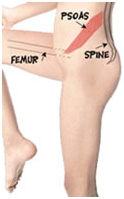The “flat stomach” myth is the pseudo ticket to stereotyped beauty, especially but not only, among women. The obsession with the abdominal area can cause frustration, anxiety, and lead to poor posture and back pain. The Good News is that our abdominals are not designed to be flat but rounded!
What are the abdominal muscles?
The primary actions of the rectus abdominis (usually referred to as the “6 packs abs”) are to compress the abdominal contents or move the ribcage in relation to the pelvis.
Look at the picture in fig 1. See how the grey band attaches from the ribs to the pubic bone?.
Now, please close your eyes and contract your abs….feel how the upper torso gets closer to the pelvis. If you feel uncertain about how to contract your abs, you can use this shortcut: just cough a little and you will notice your ribs getting closer to your pubic bone.
Another function of the abdominal muscles is to help with the movement of our intestines, also known as peristalsis. Some “experts” think that several constipation cases may be entirely related to over-contracted rectus abdominis that interfere with intestinal peristalsis.
Place your hands on your tummy and try move your hands in circles just by contracting your abs. You will feel the connection between these muscles and your gut especially if your intestines speak to you right there and then!. By the way, this exercise may come handy when constipated too!.
For information about organ massage through abdominal muscle work, please follow this link. The pictures are impressive!
Words on abdominal exercises
It could be worth exploring a different purpose to abdominal exercises, other than the famous “Six Pack Abs”.
I invite you to consider abdominal exercises as a means to improve coordination of the abdominal muscles with the other muscles of the trunk and legs to improve alignment.
High abdominal muscle tone from too many isolated exercises (abdominal crunches, for example) may interfere with the ability to stand fully erect, as the contracted abdominal muscles drag the front of the ribs down.
“But abdominal work-out will free me from back pain!”…you may argue. And it’s true, our precious abs will help us with back pain if we allow them to work in concert with other muscles, among which the most important is the psoas.
Who is this “Psoas”?
Your psoas muscles are the main muscles that raise your leg towards your body. They are attached to the spine, they run right through your abdomen and insert to the upper portion of your legs.
What about my protruding belly?
We have learnt that a protruding belly either indicates weak abdominal muscles or lordosis. Let’s take a deeper look at this belief.
The lumbar curve of the spine is normal and beneficial. It helps the spine absorb shock from running and jumping, for example. Now, an exaggerated lumbar curve, known as lordosis, may bring imbalances in the area of the lower back and may require special attention.
The large psoas muscles originate from the lower back and run anterior to the pelvis to the legs. Because of their anterior location and because they send fibers to the lumbar vertebrae, good tone of the psoas tends to oppose lordosis and guess what? it also flattens the stomach. Tight psoas muscles pull the spine forward and push the abdominal contents forward, causing protrusion.
The Balancing Approach
When the psoas muscles achieve their proper length and responsiveness, they stabilize the lumbar spine, giving the feeling of better support and “strength,” and cause the spine and abdomen to fall back, giving the appearance of “strong” abdominal muscles and the feel of a strong core.
To improve psoas functioning, a different approach to abdominal exercises than the one commonly practiced is necessary. Instead of “strengthening,” the emphasis could be on awareness, control, balancing and coordination of the involved muscles.
That means that you become more connected to the ways you use your body and the exercises become a tool to exercise that connection. For videos, books, stretching and other articles on the Psoas connection please follow this link; i really enjoyed this website’s tips!
Other ways to connect to your body’s alignment
Acupuncture
Acupuncture treatments will help you get in touch with the kind of activity occurring along and throughout your meridian system.
For cases like pain coming from tight Psoas, sciatica and back pain in general, I like to use Dr Manaka’s Ion pumping cords in combination with Moxa therapy and stretching exercises. These three treatments together will unblock the channels and redirect the excess towards other places in your body that might need that “extra” energy.
Chi Kung
You can also choose to give yourself an acupuncture session every day by learning a series of movements coming from this ancient Chinese self healing system that integrates physical postures, breathing techniques and focused intention.
My patients really enjoy becoming experts on how their Chi flows in the body. At the same time, I find Chi Kung to be an excellent home therapy to enhance and potentate the treatments I provide in my office.
The only investment needed is willingness to practice during a half-hour to an hour each day; the dividends of better health, increased vitality, and peaceful alertness accrue daily and are cumulative.
In Summary…
The strategy of strengthening the abdominal muscles could be a misguided effort to correct problems that usually lie elsewhere – which explains why, even though abdominal strengthening exercises are so popular back pain is still so common.
The good news is that you may use your knowledge about abdominal work and expand it through Exercise, Acupuncture, Chi Kung or just by the sole and powerful action of bringing your awareness into that area of your body with the intention and curiosity to explore different ways to relate to the vast mystery that lies within yourself!


